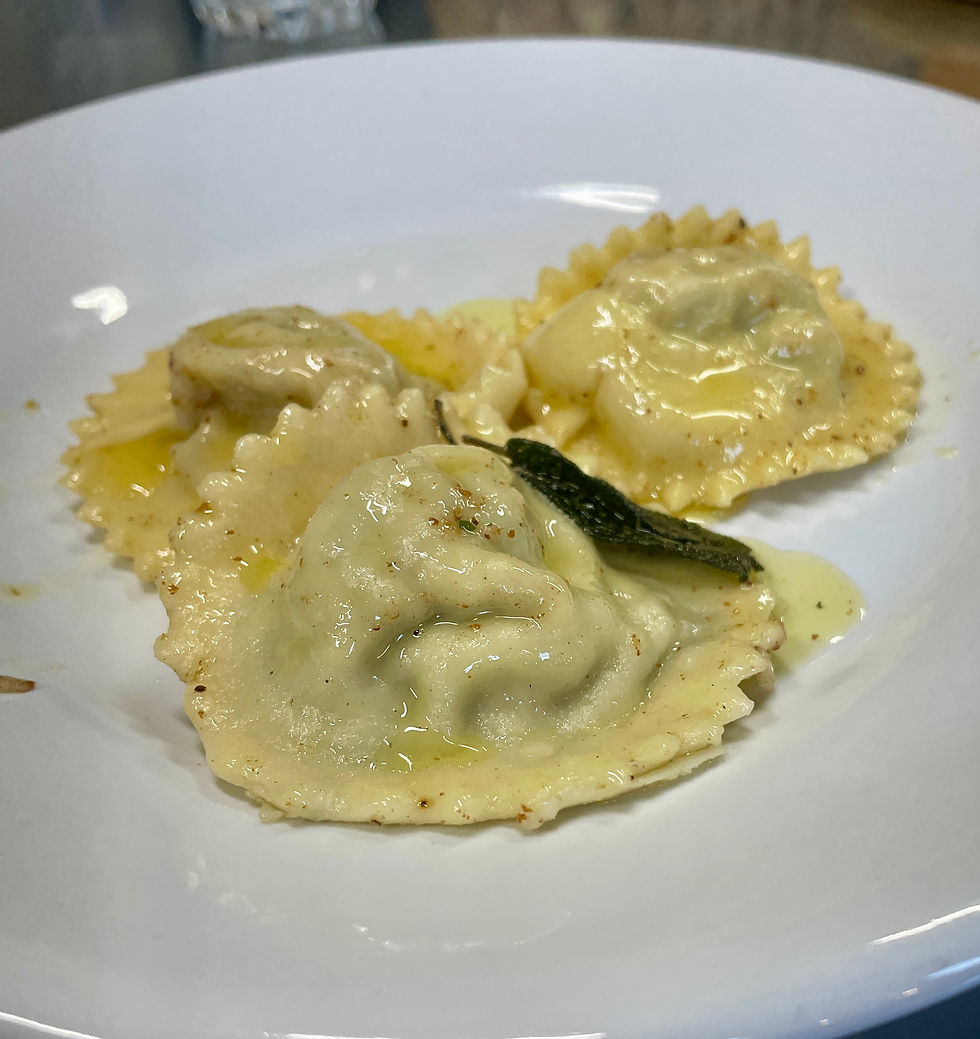Cavatelli
- marinatotta

- Nov 27, 2021
- 4 min read
Updated: Aug 7, 2025

Oh, cavatelli, I love you! Probably one of my favourite pasta shape ever!
Making cavatelli is so easy, relaxing, and therapeutic for me! So, if you are new to the pasta making world this is probably the shape to start with.
The dough is made with semolina flour, salt, and warm water; at least the most known versions are, but you can also find them with interesting local flours like grano arso, a nutty, smoky, and dark flour that is grown in Puglia.
Cavatelli can be made using various techniques:
- with a blunt-tipped knife drawn across the board,
- hollowed out with two or more fingers or
- using a gnocchi board or cavarola to create a shape with ridges or a pattern.
No matter how you shape them, what groups them is their hollowed shape made by being rolled or dragged on a wooden board. This dragging creates grooves that beautifully hold the sauce cavatelli will be paired with.
Cavatelli are found in southern Italy, in particular Molise, Puglia, Campania, Basilicata, Calabria and Sicily. They have acquired different names in each region and assume slightly different shapes: larger or smaller and more or less open. Some of the names they are known as are: cazzarille, cecatelli, cavatieddi, strascenate, cicatelli, capunti, raskatelli, gnocculi, truoccoli, manatelli and lolli.
And you, what do you call them?

Where to find Cavatelli in Melbourne?
Walking outside Mister Bianco in Kew was a pleasure during the lockdown, watching Joe mixing a huge pan of cavatelli with ragu. He knows how to put on a real show, and in case you missed it, you can still try their fabulous cavatelli on their menu.
Today I will be sharing the recipe of cavatelli in a gypsy sauce, an absolute favourite during my pasta classes — a sauce that is very well balanced and easy to prepare.
If you want to learn how to make cavatelli with me check for the next Hand-rolled Pasta Class here
CAVATELLI WITH GYPSY SAUCE
Serves 4
Preparation time 1 hour – resting time 30 min – cooking time 40 min
Pasta dough:
300g semolina (1 and ½ cup)
150ml (2/3 cup) warm water
A pinch of salt
‘Gypsy’ sauce:
100g unsmoked pork belly, cubed or sliced (optional for a vegan version)
4 Tbsp olive oil
½ brown onion, finely chopped
200g sliced mushrooms
50g green olives, destoned and preferably from Sicily (you can find them at the Deli counter)
400g (1 can) tinned tomatoes, preferably whole
1/3 teaspoon chili flakes
Salt & black pepper
1 Tbsp chopped parsley
6 Tbsp grated Parmigiano Reggiano, preferably aged for 24 months, freshly grated.
Tools needed:
- Gnocchi board, a knife, or just your hands
- A wooden board to roll the pasta in
- A saucepan for the sauce
- A medium-sized pot to boil pasta in
Making the dough:
Place the flour in a bowl. Make a well and add a pinch of salt. Gently mix to combine.
Slowly incorporate 150 ml warm water into the flour, using a fork to mix.
Put the dough on a wooden surface and knead until smooth and resilient for about 10 minutes.
Cover the dough with a tea towel or a bowl and let it rest for at least 20 minutes before using.
Cut off half of the dough and roll the section into a disc about 1 centimeter thick with a rolling pin or using your hands.
Cut the disc into strips about 1 centimeter wide and roll them into cylinders as thick as a pencil. Finally, cut the cylinders into approximately 1 cm pieces.
If you’re using a gnocchi board:
Firmly roll each piece away from you onto a gnocchi board with the side of your thumb. The result will be a cavatello with ridges that look like a little gnocco.
If you’re using a blunt-tipped knife:
Draw the pieces of dough across a wooden board towards you.
If you’re using your hands:
Draw the pieces of dough across a wooden board towards you with your index and medium finger.
Once you’ve used all the dough, place the cavatelli on a tray with a tea towel.
CHECK MY IG PAGE FOR A VIDEO ON HOW TO SHAPE THEM
Making the sauce:
Chop the pancetta into little cubes – about ½ cm, ideally – or thin slices and then fry them in the saucepan with the olive oil. Add the onion and continue frying for about 5 min on a medium flame until softened. Raise the flame to be medium-high and add the mushrooms; cook for 2-3 minutes. Finally, bring the flame back to medium, add the olives and chili, and cook for 2 minutes. Add the tinned tomatoes and pepper and let everything simmer for around 40 minutes on a very gentle flame. Taste the sauce after 20 min and see if it needs salt – it will depend on your olives.
When the sauce is cooked, add the chopped parsley and stir well.
Cooking pasta:
Bring a pot of salted water to a boil. Cook pasta until tender, about 4 minutes. Drain and reserve ¼ cup of pasta water. Add the pasta to the sauce and toss to combine. Add pasta water if more liquid is required. Drizzle with the remaining olive oil.
Divide between bowls, sprinkle some Parmigiano Reggiano, and serve immediately.



